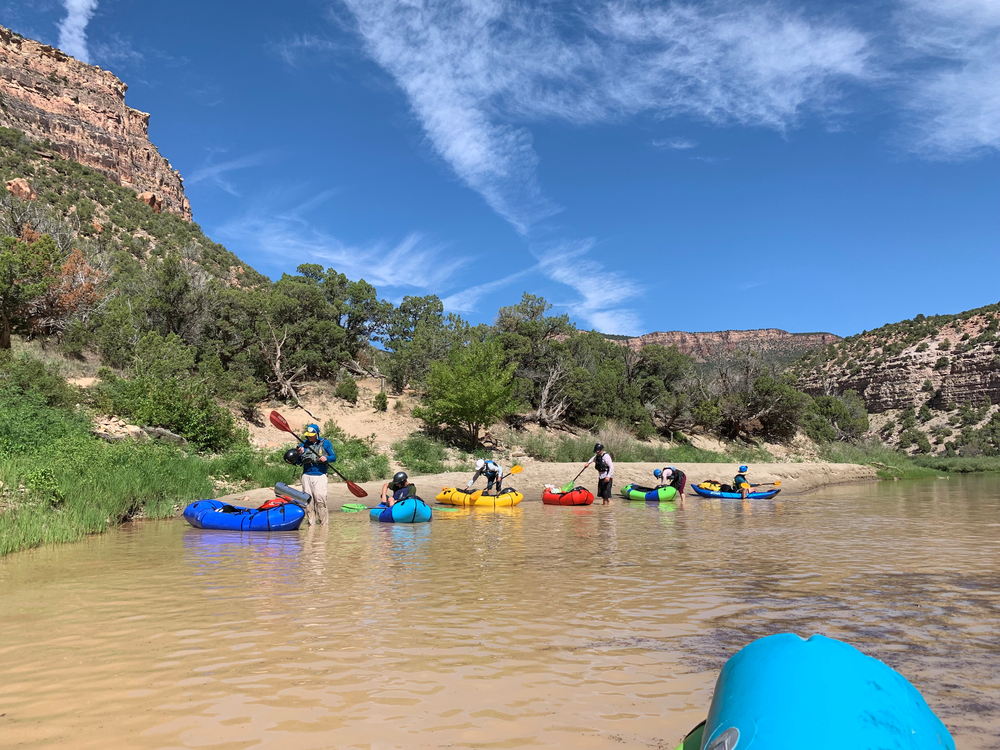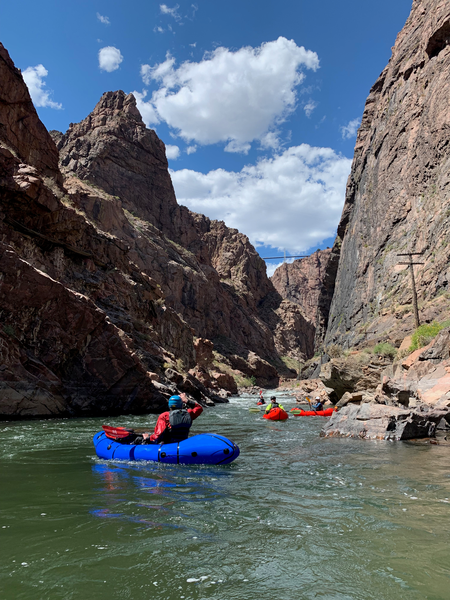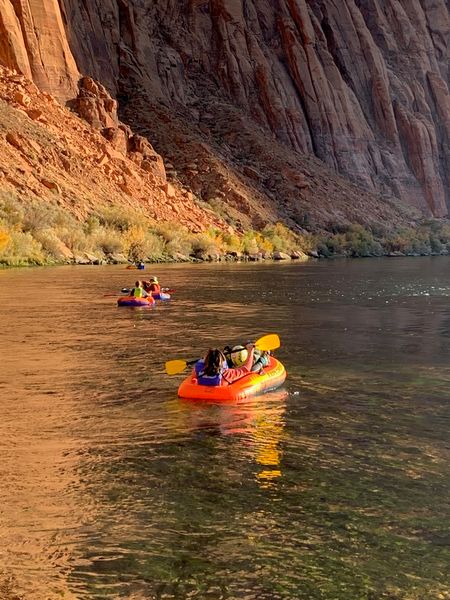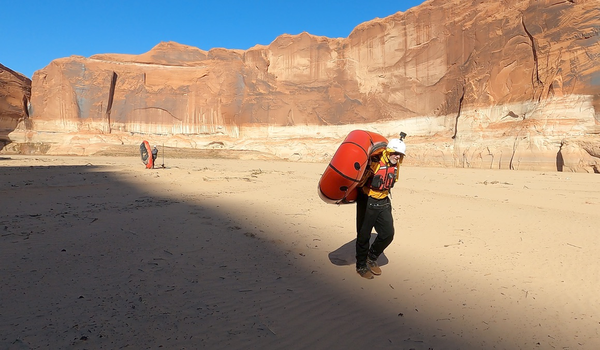
Mountaineers have a history of changing and adapting with the times. We adjust our courses and activities to respond to new safety practices, revolutionary gear, and the ever-evolving passions of our community. Take packrafting, for example. These inflatable “packable” rafts began to appear in army surplus stores in the 1950s – leftover survival equipment from WWII airplanes. Packrafting has recently enjoyed a surge in popularity as lighter-weight versions have become available. And recently our volunteers got together to create the Seattle Packrafting Committee to share their love with other rafters and soon-to-be-rafters in the Pacific Northwest.
Though not as popular as other outdoor activities like hiking or climbing (yet!), packrafting offers a unique mode of travel to explore the waterways of Washington in a way that’s fun and accessible. Packrafts, which can roll up to be the size of a tent and fit in your backpack, are beloved by adventurers of all kinds, whether enjoying a day-only rafting or trying to incorporate rafts into larger, multi-sport trips.
Packrafting differs from other water sports like kayaking. A packraft is designed to be lightweight and pack down once deflated. They can be inflated without the use of power, and can accompany recreationists places where larger watercraft would be challenging or less convenient to bring. They are small, durable, and up to the task of long water travel, with many advanced enough to tackle class IV (advanced) and V (expert) level rapids. Even storage is a cinch – with an airtight cargo zipper located in the raft’s tubes, your gear stays dry and helps to provide weight and stability to the raft when in use.
Though we will not say goodbye to kayaking anytime soon, we were thrilled to welcome packrafting into our course ranks as a new, accessible, and convenient way to explore Washington’s waters.
 Packrafters eddying out to strategize a safety plan above a Class IV rapid in the Royal Gorge canyon of the Arkansas River, Colorado. Photo by Logan DeGrand.
Packrafters eddying out to strategize a safety plan above a Class IV rapid in the Royal Gorge canyon of the Arkansas River, Colorado. Photo by Logan DeGrand.
The Mountaineers Packrafting Committee
Our Packrafting Course began with volunteers Logan DeGrand and Tom Unger, the founding members of the Packrafting Committee.
Logan discovered packrafting as a novel mode of travel to access canyon routes after many years establishing first descents as a canyoneer. He quickly learned that it’s a fun activity in its own right, attending his first American Packrafting Association Roundup five years ago. Logan worked as a whitewater river guide in Moab, Utah, and was excited to bring this new sport to The Mountaineers.
Tom joined The Mountaineers in the mid-90s as a climber. He left to pursue other endeavors, but returned in 2015 to join the Seattle Sea Kayaking Committee as a trip leader. He was thrilled to help kick-start the new Packrafting Committee in part to renew his pool of paddling trip partners! Tom and Logan gained their experience thanks to the education and support offered by paddling instructors and leaders over the years. They are eager to pay it forward through the Packrafting Committee, and to share the joy of a day on the water.
 Canyoneers using packrafts as the only means to exit a technical slot canyon in the Grand Canyon. Colorado River. Photo by logan degrand
Canyoneers using packrafts as the only means to exit a technical slot canyon in the Grand Canyon. Colorado River. Photo by logan degrand
River travel
The focus of the Packrafting Committee is river travel, which historically has been a primary mode of transportation for wilderness travel. “Rivers are a challenge to move through, but exceedingly fun to go down. That's really what I want to do with packrafting - go down rivers,” said Tom. Because packrafts can carry more gear than hard shell kayaks and are easier to transport, they enable you to embark on multi-week expeditions and explore places that would otherwise be difficult to reach.
Convenience & affordability
Packrafting is well-suited for those who desire a lower-cost and convenient method of exploring waterways. A packraft and paddle weigh around eight pounds, with the raft rolling up to be slightly larger than a football. This allows it to fit in your backpack and be carried for miles. “It allows you to do a lot of really fun river runs. Which, up until now, you would have needed a hard shell kayak or a big river raft for. The activity has blossomed in recent years with advances in how they make the boats. Thus, packrafting has become a sport in its own right because they’re easy to use to access rivers,” said Logan.
Financial accessibility was a matter of concern during initial committee conversations. They acknowledged the steep price that can arise when finding a place to store hard shell kayaks, and a car to transport them. With the small equipment, more packrafters can carpool, making trip logistics far simpler. Add the impracticality of storing a kayak and how renting can add up over time, and packrafts start to make a lot of sense.
Get involved
Tom and Logan are eager to engage The Mountaineers community in this new and exciting activity. Those with a packrafting, whitewater, or kayaking background can consider the equivalency course to join the committee as a volunteer leader or instructor. Those with no experience on the water are also strongly encouraged to get involved through the course. The Seattle Packrafting Committee will be offering equivalency this summer, and the first basic packrafting skills training courses will be available in the fall. For more information, visit our Seattle Packrafting Committee webpage.
 Brad Mitchell portaging his packraft through a large river bend near Escalante River, Utah. Photo by Tom Unger.
Brad Mitchell portaging his packraft through a large river bend near Escalante River, Utah. Photo by Tom Unger.
PRO TIP: TURNING JARGON INTO VOCABULARY
One common mistake made by leaders is forgetting that their vocabulary is, in fact, jargon to the average person. You may have a level of experience with the subject where you take terminology for granted. This may seem small, but it can have a significant impact on the students’ ability to learn. Students can miss entire lessons if they are dedicating energy to trying to interpret what you're saying.
As instructors, we can make an unconscious assumption that students understand the jargon that we take for granted. A great example is the bowline knot, which is used in nearly every outdoor activity that involves ropes. Bowline is pronounced “boh-lin.” Often students will have to study knots before a class session. When the instructor refers to a “boh-lin” without the written word accompanying the lesson, the students can become lost, and may think there’s a knot they somehow forgot to study.
Another example is how often there is more than one term used to describe something technical. During a knot demonstration, an instructor may refer to the "working end," "standing end," or the “running end” of the rope. Using multiple terms without clarification can easily confuse students and greatly distract from the lesson.
By taking time to introduce the vocabulary you plan to use, you can set students up for success and maximize the outcomes of your lessons.
Want to continue expanding your leadership skills? Check out our Leader Resources page.
This article originally appeared in our Summer 2022 issue of Mountaineer magazine. To view the original article in magazine form and read more stories from our publication, visit our magazine archive.
 Michelle Song
Michelle Song